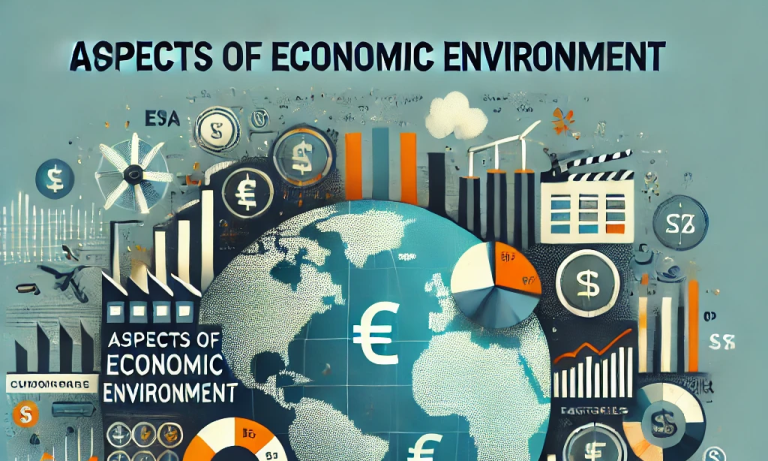Aspects of the Economic Environment are considered factors and policies that impact the country’s business climate, industrial growth, and economic stability. Examples of these include elements such as GDP, inflation, interest rates, trade policies, and government regulations. Therefore, a proper understanding of the economic environment is very important to a business in terms of adjustment to change, optimizing the firm’s operations, and strategic long-term planning. Economic policies, such as liberalization, privatization, and globalization (LPG), have profoundly affected the economy of India, thus highlighting the need to monitor all these factors.
Elements of Economic Environment
Elements of the economic environment shape the collective economy of the country, determining its effects upon businesses and people. It reflects the way an economy is performing, in structure, and in direction.
Economic Indicators
- Gross Domestic Product (GDP):
- Measures the total value of goods and services produced in a country.
- Indicator of economic health and growth rate.
- Inflation Rate:
- Represents the rate at which prices of goods and services rise.
- Impacts purchasing power and cost of living.
- Unemployment Rate:
- Indicates the percentage of the workforce that is jobless.
- Affects consumer spending and economic stability.
Economic Systems
- Capitalist Economy:
- Relies on free markets and minimal government intervention.
- Socialist Economy:
- Emphasizes state control over resources and equal wealth distribution.
- Mixed Economy:
- Combines elements of capitalism and socialism; prevalent in countries like India.
Economic Policies
- Fiscal policy, monetary policy, and trade policy shape the business climate.
- Taxation, government spending, and interest rates impact consumer behavior and investment.
Trade and Foreign Exchange
- Export and import policies influence international trade and foreign investment.
- Exchange rates affect the competitiveness of a country’s goods in global markets.
Technological Advancements
- Innovations drive productivity and efficiency in various industries.
- Impact on job creation, industrial growth, and consumer demand.
By analyzing these elements, businesses can make informed decisions to navigate opportunities and challenges effectively.
Role of Economic Policies
Economic policies refer to strategic tools applied by the government for controlling, stabilizing, and enhancing economic growth. Since economic policies influence businesses, industries, and consumers, they play an essential role in shaping the economic environment.
- Fiscal Policy:
- Refers to government actions on taxation and public spending to influence the economy.
- Impact:
- High taxation may reduce consumer spending.
- Increased government spending boosts infrastructure development and job creation.
- Monetary Policy:
- Managed by central banks to control money supply and interest rates.
- Impact:
- Lower interest rates encourage borrowing and investment.
- Controlling inflation ensures economic stability.
- Trade Policy:
- Regulates exports, imports, and trade agreements with other nations.
- Impact:
- Promotes international trade and foreign direct investment (FDI).
- Protects domestic industries from excessive foreign competition.
- Industrial Policy:
- Focuses on boosting specific industries through incentives and regulations.
- Impact:
- Encourages innovation and industrial diversification.
Objectives of Economic Policies
- Economic Stability: Reducing volatility in markets and stabilizing growth.
- Employment Generation: Creating jobs through infrastructure projects and industrial expansion.
- Equitable Distribution of Wealth: Reducing income inequality through social welfare programs.
Example
In India, monetary policy decisions by the Reserve Bank of India (RBI) have a deep impact on interest rates, inflation, and credit availability, which again have an impact on consumer behavior and industrial growth.Economic policies serve as the levers through which the government steers the economy towards intended objectives, such as sustainable growth and social equity.
Impact of LPG Policies in India
The LPG Policies (Liberalization, Privatization, and Globalization) introduced in India in 1991 was a very transformative phase of the country’s economic environment. It was to open up the economy, reduce government control, and integrate India into the global market.
Liberalization
- Definition:
- Relaxation of government restrictions on industries and markets.
- Impact:
- Removed licensing requirements for several sectors.
- Encouraged competition and reduced monopolies.
- Boosted industrial growth and innovation.
Privatization
- Definition:
- Transfer of ownership and management of state-owned enterprises to private entities.
- Impact:
- Enhanced efficiency and productivity of industries.
- Increased private sector participation in sectors like telecommunications and aviation.
- Reduced fiscal burden on the government.
Globalization
- Definition:
- Integration of the Indian economy with the global market through trade and investment.
- Impact:
- Boosted foreign direct investment (FDI) in multiple sectors.
- Expanded export opportunities for Indian industries.
- Facilitated access to advanced technologies and global markets.
Outcomes of LPG Policies
- Economic Growth:
- The GDP growth rate increased significantly post-1991 reforms.
- Employment Generation:
- Expansion of industries and foreign investments created numerous job opportunities.
- Improved Infrastructure:
- Enhanced infrastructure development through public-private partnerships.
Challenges
- Income Inequality: Rapid growth benefited certain sections of society disproportionately.
- Dependence on Imports: Increased reliance on foreign goods and services.
The LPG policies changed India into a more dynamic, globally competitive economy and posed new challenges needing effective policy responses.
Conclusion
Understanding the various elements of the economic environment is one way in which businesses and policymakers can manage the intricacies of the contemporary economy. The factors comprising the economic environment, such as GDP, inflation, and trade policies, influence the opportunities and challenges that industries face. Economic policies, which include fiscal and monetary actions, are instruments for attaining stability and growth. LPG policies in India have effectively shown how reforms can create such an impact on economic development. Following these aspects, one can guarantee sustainable growth and resilience in a changing world.
Aspects of Economic Environment FAQs
What are the aspects of the economic environment?
The aspects include economic indicators (GDP, inflation), trade policies, monetary and fiscal policies, and technological advancements.
What are the elements of the economic environment?
Key elements include economic systems, trade and foreign exchange, government policies, and technological progress.
What is the impact of LPG policies in India?
LPG policies led to liberalization, privatization, and globalization, boosting GDP growth, foreign investments, and infrastructure development in India.
How do economic policies influence businesses?
Economic policies like fiscal and monetary measures affect taxation, borrowing costs, and trade conditions, influencing business strategies and profitability.
Why is understanding the economic environment important?
Understanding the economic environment helps businesses adapt to market changes, mitigate risks, and seize growth opportunities effectively.


